Development of Monitoring Technology for Mine Haulage Road through Sensor-Connected Digital Device and Smartphone Application
Abstract
1. Introduction
2. Study Area
3. Methods
3.1. Development of Digital Device Using Arduino and Sensors
3.2. Development of Data Sharing Application for the Smartphone
4. Results
4.1. Preliminary Test at the University
4.2. Field Test at the Samdo Mine
5. Conclusions
Author Contributions
Funding
Conflicts of Interest
References
- S&P Global Market Intelligence. Available online: https://www.spglobal.com/marketintelligence/en/news-insights/latest-news-headlines/as-us-coal-demand-surged-worker-fatalities-doubled-yoy-in-2021-68234862 (accessed on 7 April 2022).
- Korea Resources Corporation (KORES). Mine Disaster Statistics Data; KORES: Wonju, Korea, 2020; pp. 1–175. [Google Scholar]
- Centers for Disease Control and Prevention. Available online: https://www.cdc.gov/niosh/mining/works/statistics/factsheets/miningfacts2015.html (accessed on 17 January 2022).
- Choi, Y.S.; Suh, J.W.; Park, H.D.; Sunwoo, C. Application of GIS-based Viewshed Analysis for Selecting Optimal Viewpoints and for Evaluating the Sight Distance on a Haul Road in Open-pit Mines. J. Korean Soc. Miner. Energy Resour. Eng. 2018, 45, 265–275. [Google Scholar]
- Choi, Y.S.; Park, H.D.; Sunwoo, C.; Clarke, K.C. Multi-criteria Evaluation and Least-cost Path Analysis for Optimal Haulage Routing of Dump Trucks in Large Scale Open-pit Mines. Int. J. Geogr. Inf. Sci. 2009, 23, 1541–1567. [Google Scholar] [CrossRef]
- Baek, J.E.; Choi, Y.S.; Lee, C.Y.; Suh, J.W.; Lee, S.H. BBUNS: Bluetooth Beacon-based Underground Navigation System to Support Mine Haulage Operations. Minerals 2017, 7, 228. [Google Scholar] [CrossRef]
- Baek, J.E.; Suh, J.W.; Choi, Y.S. Analysis of Received Signal Strength Index from Bluetooth Beacons to Develop Proximity Warning Systems for Underground Mines. J. Korean Soc. Miner. Energy Resour. Eng. 2018, 55, 604–613. [Google Scholar] [CrossRef]
- Sun, E.; Nieto, A.; Li, Z. GPS and Google Earth Based 3D Assisted Driving System for Trucks in Surface Mines. Min. Sci. Technol. 2010, 20, 138–142. [Google Scholar] [CrossRef]
- Sunwoo, C.; Jung, Y.B.; Choi, Y.S.; Park, H.D. Failure Prediction for Weak Rock Slopes in a Large Open-pit Mine by GPS Measurements and Assessment of Landslide Susceptibility. Eng. Geol. 2010, 20, 243–255. [Google Scholar]
- Park, S.B.; Choi, Y.S. Bluetooth Beacon-Based Mine Production Management Application to Support Ore Haulage Operations in Underground Mines. Sustainability 2021, 13, 2281. [Google Scholar] [CrossRef]
- Tang, S.; Fan, M.; Ma, G. Application of Bluetooth in Mine Gas Information Transmission. IOP Conf. Ser. Earth Environ. Sci. 2019, 242, 022014. [Google Scholar] [CrossRef]
- Nithya, T.; Ezak, M.M.; Kumar, K.R.; Vignesh, V.; Vimala, D. Rescue and Protection System for Underground Mine Workers Based On ZIGBEE. Int. J. Rec. Res. Asp. 2017, 4, 194–197. [Google Scholar]
- Bin, G.; Li, H. The research on ZigBee-based mine safety monitoring system. In Proceedings of the International Conference on Electric Information and Control Engineering, Wuhan, China, 15–17 April 2011; pp. 1837–1840. [Google Scholar]
- Liu, X.; Huang, J.S.; Chen, Z. The Research of Ranging with Timing over Packet Network for the Mine Safety Application. J. Netw. 2012, 7, 1054–1062. [Google Scholar] [CrossRef]
- Min, C.; Jinhao, Z. The Application of WiFi 6 Technology in Underground Mine. IOP Conf. Ser. Earth Environ. Sci. 2021, 687, 012153. [Google Scholar] [CrossRef]
- Lee, W.H.; Kim, H.; Lee, C.H.; Kim, S.M. Development of Vibration and Dust Monitoring Technology in Underground Mines using Zigbee-based Wireless Sensor Network. J. Korean Soc. Miner. Energy Resour. Eng. 2022, 59, 137–147. [Google Scholar] [CrossRef]
- Park, Y.H.; Lee, H.K.; Seo, M.K.; Kim, J. A Study on the Application of Real-time Environment Monitoring System in Underground Mines Using Zigbee. Tunn. Undergr. 2019, 29, 108–123. [Google Scholar]
- Kim, S.M. Review of Internet of Things and Open-source Hardware Technologies Use in the Mining Industry. J. Korean Soc. Miner. Energy Resour. Eng. 2019, 56, 447–456. [Google Scholar] [CrossRef]
- Kim, S.M.; Choi, Y.S.; Suh, J.W. Applications of the Open-source Hardware Arduino Platform in the Mining Industry: A review. Appl. Sci. 2020, 10, 5018. [Google Scholar] [CrossRef]
- Meocci, M.; Branzi, V. Black boxes data for road pavement conditions monitoring: A case study in Florence. In Proceedings of the 11th International Conference on the Bearing Capacity of Roads, Railways and Airfields, Trondheim, Norway, 27–30 June 2022; pp. 271–280. [Google Scholar]
- Singh, P.; Bansal, A.; Kamal, A.E.; Kumar, S. Road monitoring and sensing system using mobile sensors. In Proceedings of the 12th International Conference on Cloud Computing, Data Science & Engineering (Confluence), Uttar Pradesh, India, 27–28 January 2022; pp. 165–170. [Google Scholar]
- Setiawan, B.D.; Kovacs, M.; Serdült, U.; Kryssanov, V. Semantic segmentation on smartphone motion sensor data for road surface monitoring. Procedia Comput. Sci. 2022, 204, 346–353. [Google Scholar] [CrossRef]
- Kumar, T.; Acharya, D.; Lohani, D. Modeling IoT enabled classification system for road surface monitoring. In Proceedings of the 14th International Conference on COMmunication Systems & NETworkS (COMSNETS), Bengaluru, India, 3–9 January 2022; pp. 836–841. [Google Scholar]
- Sattar, S.; Li, S.; Chapman, M. Developing a near real-time road surface anomaly detection approach for road surface monitoring. Measurement 2021, 185, 109990. [Google Scholar] [CrossRef]
- Partridge, T.; Gherman, L.; Morris, D.; Light, R.; Leslie, A.; Sharkey, D.; McNally, D.; Crowe, J. Smartphone monitoring of in-ambulance vibration and noise. J. Eng. Med. 2021, 235, 428–436. [Google Scholar] [CrossRef]
- New Civil Engineer. Available online: https://www.newcivilengineer.com/innovative-thinking/connected-sensors-to-monitor-scotlands-rural-roads-26-07-2022 (accessed on 6 October 2022).
- Intel. Available online: https://www.intel.co.kr/content/www/kr/ko/transportation/smart-road-infrastructure.html (accessed on 7 October 2022).
- Od, S.; Hsu, H.C.; Wei, J.B. Improve the indoor air quality based on internet of things. In Proceedings of the IEEE 3rd Eurasia Conference on Biomedical Engineering, Healthcare and Sustainability (ECBIOS), Tainan, Taiwan, 28–30 May 2021; pp. 105–108. [Google Scholar]
- Jabbar, W.A.; Subramaniam, T.; Ong, A.E.; Shu’Ib, M.I.; Wu, W.; de Oliveira, M.A. LoRaWAN-based IoT system implementation for long-range outdoor air quality monitoring. Internet Things 2022, 19, 100540. [Google Scholar] [CrossRef]
- Jumaa, N.K.; Abdulkhaleq, Y.M.; Nadhim, M.A.; Abbas, T.A. IoT Based Gas Leakage Detection and Alarming System using Blynk platforms. Iraqi J. Electr. Electron. Eng. 2022, 18, 64–70. [Google Scholar] [CrossRef]
- Yadav, H.; Oyiza, N.; Hassan, S.; Lata, S.; Chitra, K.J. IoT based industrial monitoring system. Int. Res. J. Mod. Eng. Technol. Sci. 2022, 4, 2474–2479. [Google Scholar]
- Khan, A.; Chandra, S.; Parameshwara, M.C. Air quality monitoring and management system model of vehicles based on the internet of things. Eng. Res. Expr. 2022, 4, 025014. [Google Scholar] [CrossRef]
- Pulse. Available online: https://pulsenews.co.kr/view.php?sc=30800028&year=2020&no=291177 (accessed on 1 October 2022).
- Park, Y.K. Connected Car Based on IoT, Smart Car. Smart Media J. 2014, 3, 29–31. [Google Scholar]
- Digital Times. Available online: http://www.dt.co.kr/contents.html?article_no=2019102302101331032001 (accessed on 2 May 2022).
- MIT App Inventor. Available online: http://appinventor.mit.edu/explore (accessed on 22 January 2022).

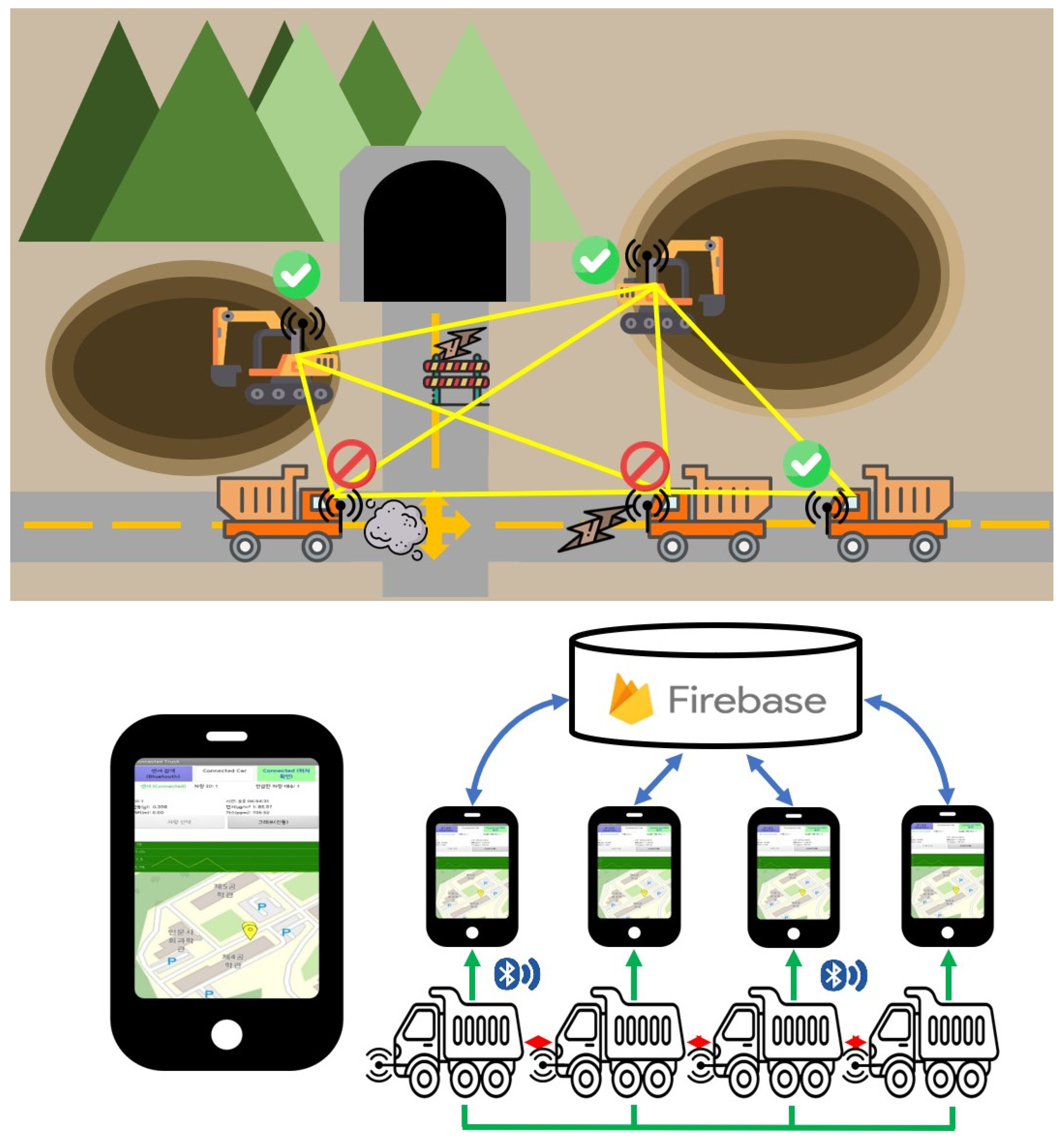


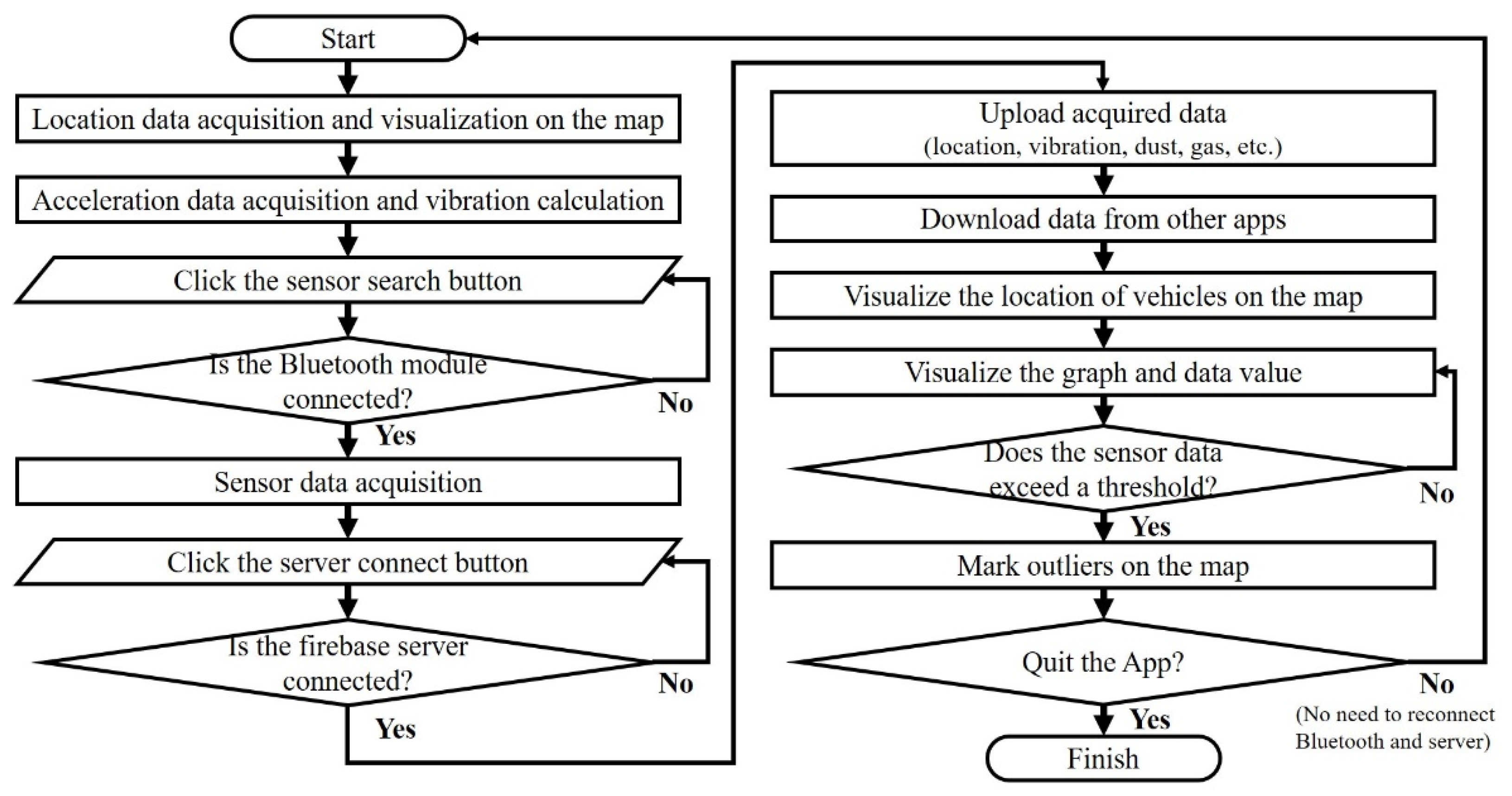

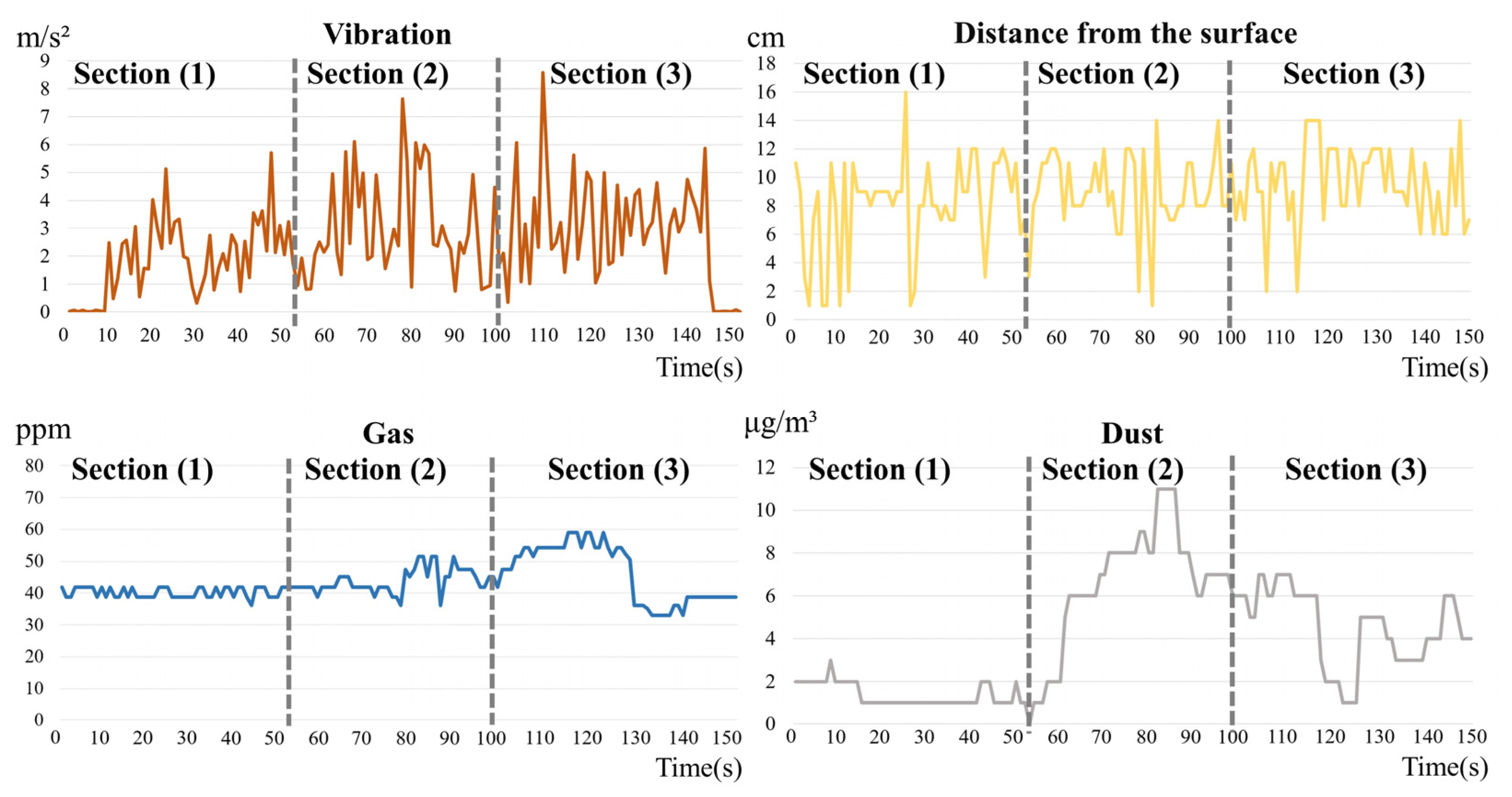
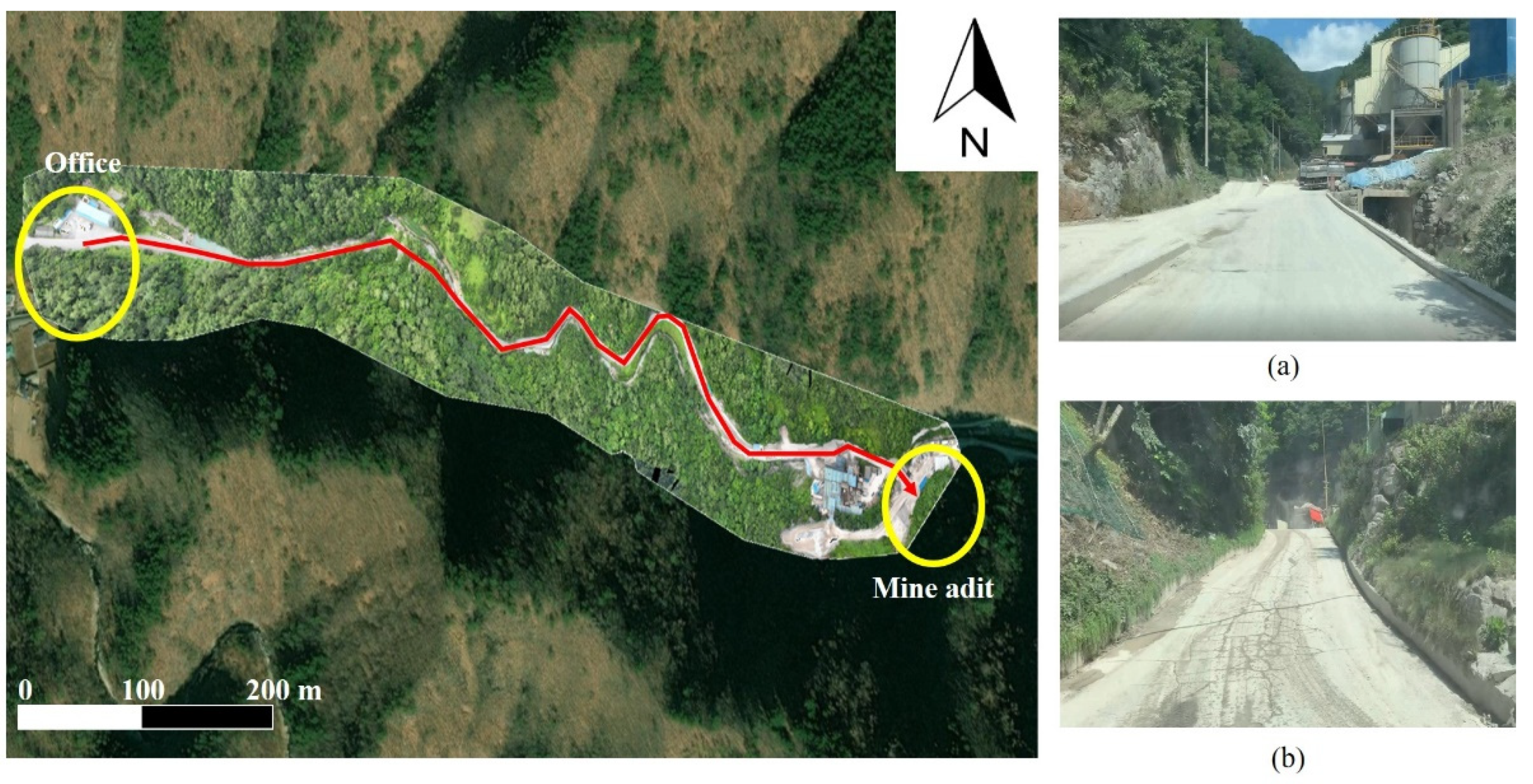
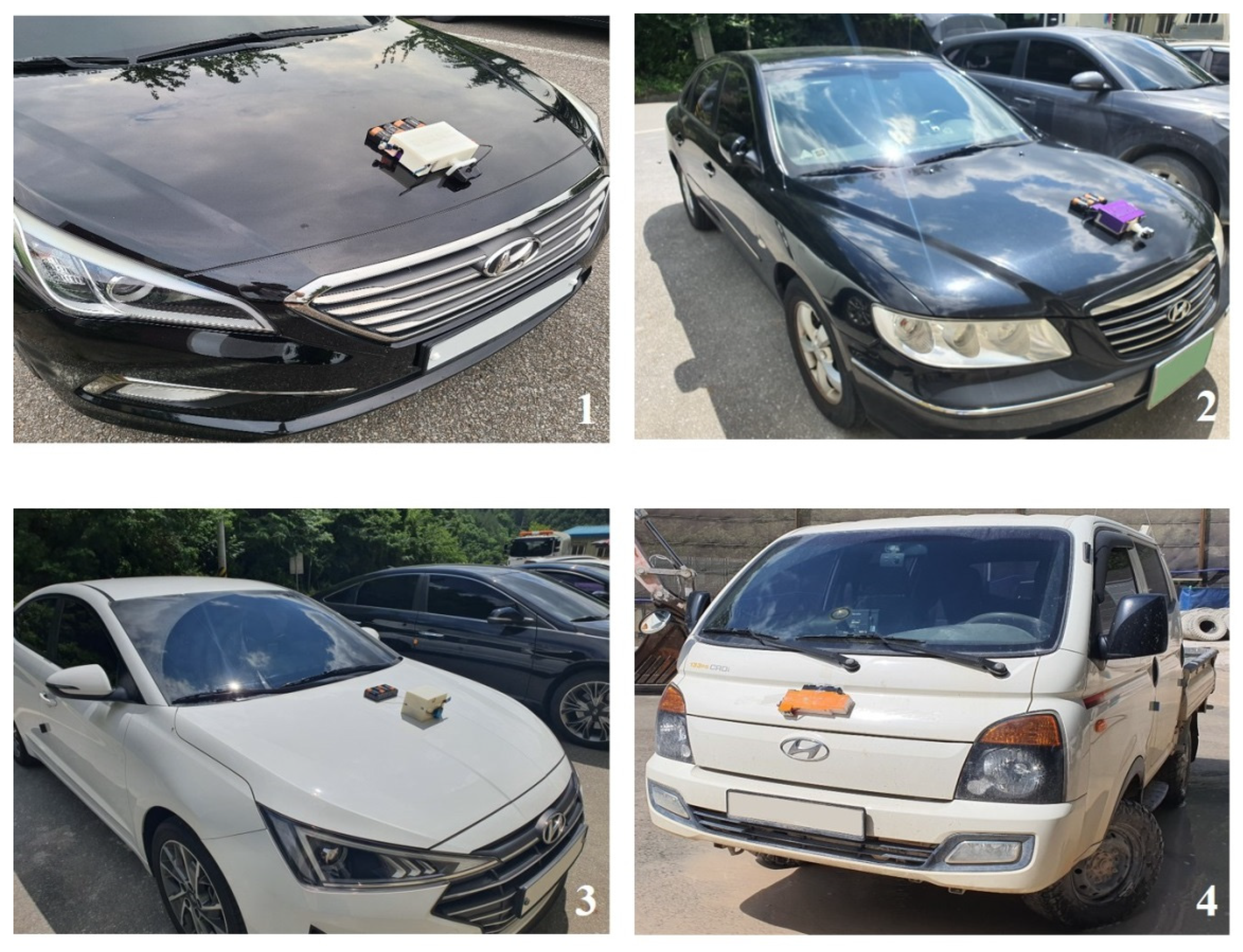

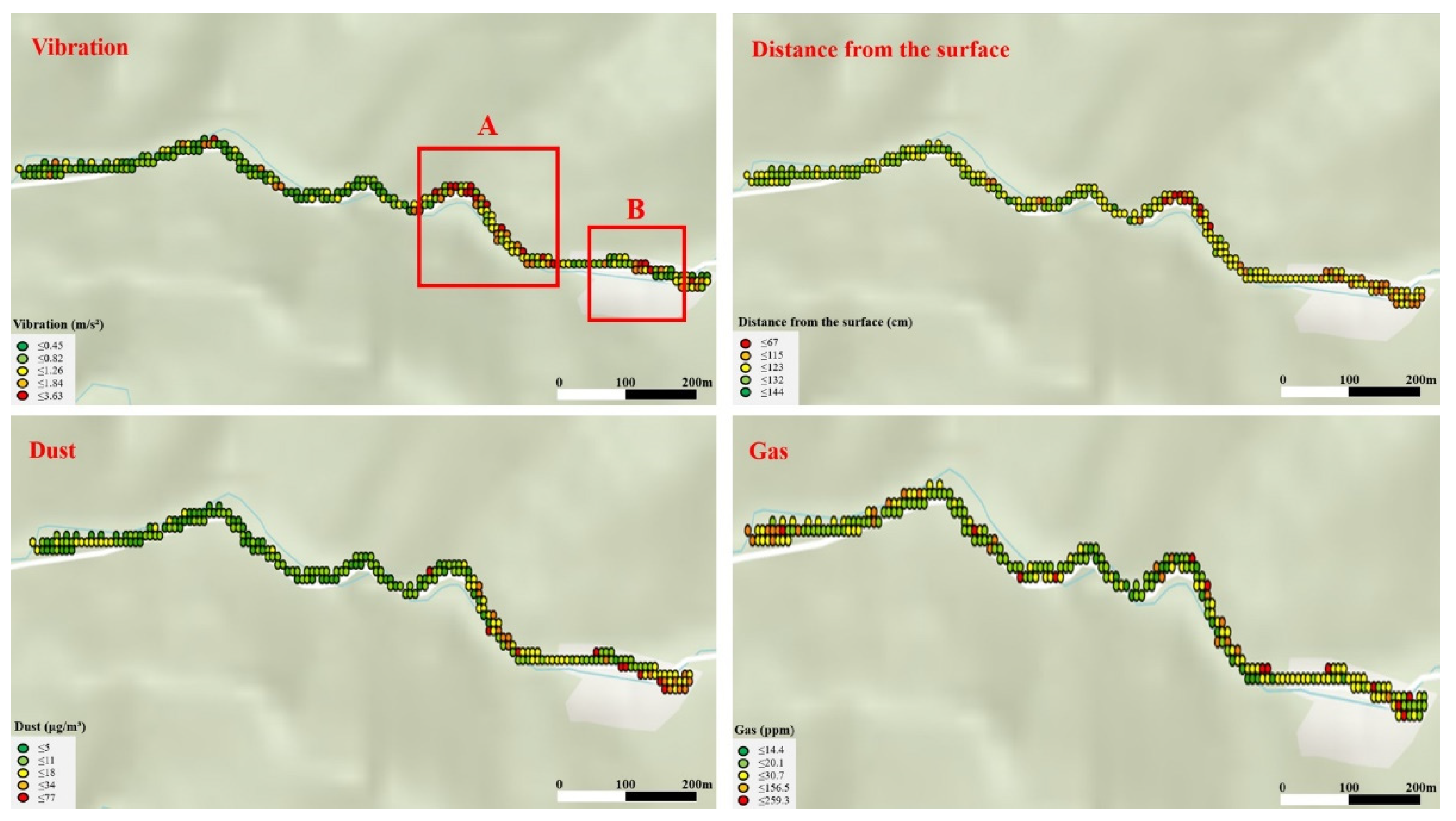
| Sub-Field | References | Year | Real-Time Data Sharing | Positioning | Aim of Study |
|---|---|---|---|---|---|
| Road conditions | Meocci and Branzi [20] | 2022 | No | No | Road condition monitoring using the acceleration measurement function of the black box |
| Singh et al. [21] | 2022 | No | No | Road condition monitoring using smartphone built-in motion sensors | |
| Setiawan et al. [22] | 2022 | No | No | Road condition monitoring using smartphone built-in motion sensors | |
| Kumar et al. [23] | 2022 | No | Yes | Road condition monitoring using smartphone built-in motion sensors | |
| Sattar et al. [24] | 2021 | No | Yes | Road condition monitoring using smartphone built-in motion sensors | |
| Partridge et al. [25] | 2020 | No | No | Road vibration and noise monitoring using a smartphone for an ambulance | |
| Air quality | Od et al. [28] | 2021 | Yes | No | Air quality monitoring using PM2.5 and CO2 sensors with a smartphone application |
| Jabbar et al. [29] | 2022 | Yes | No | Air quality monitoring using various sensors with a smartphone application | |
| Jumaa et al. [30] | 2022 | Yes | No | Gas leakage detection and alarm system with a smartphone application | |
| Yadav et al. [31] | 2022 | Yes | No | Industrial monitoring using temperature, humidity, and smoke sensors | |
| Khan et al. [32] | 2022 | Yes | Yes | Air quality monitoring using various sensors and GPS for vehicles |
Publisher’s Note: MDPI stays neutral with regard to jurisdictional claims in published maps and institutional affiliations. |
© 2022 by the authors. Licensee MDPI, Basel, Switzerland. This article is an open access article distributed under the terms and conditions of the Creative Commons Attribution (CC BY) license (https://creativecommons.org/licenses/by/4.0/).
Share and Cite
Kim, H.; Lee, W.-H.; Lee, C.-H.; Kim, S.-M. Development of Monitoring Technology for Mine Haulage Road through Sensor-Connected Digital Device and Smartphone Application. Appl. Sci. 2022, 12, 12166. https://doi.org/10.3390/app122312166
Kim H, Lee W-H, Lee C-H, Kim S-M. Development of Monitoring Technology for Mine Haulage Road through Sensor-Connected Digital Device and Smartphone Application. Applied Sciences. 2022; 12(23):12166. https://doi.org/10.3390/app122312166
Chicago/Turabian StyleKim, Hojin, Woo-Hyuk Lee, Chung-Hyun Lee, and Sung-Min Kim. 2022. "Development of Monitoring Technology for Mine Haulage Road through Sensor-Connected Digital Device and Smartphone Application" Applied Sciences 12, no. 23: 12166. https://doi.org/10.3390/app122312166
APA StyleKim, H., Lee, W.-H., Lee, C.-H., & Kim, S.-M. (2022). Development of Monitoring Technology for Mine Haulage Road through Sensor-Connected Digital Device and Smartphone Application. Applied Sciences, 12(23), 12166. https://doi.org/10.3390/app122312166








